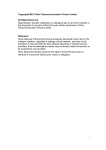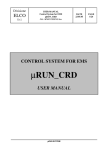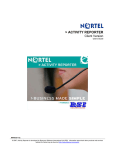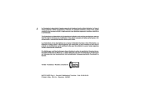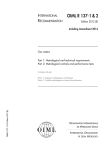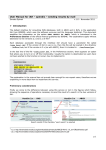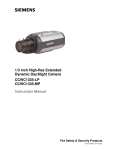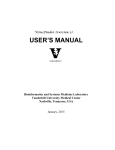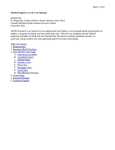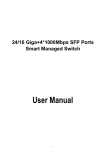Download Blat User Manual
Transcript
Blat User Manual Compiled By Mark E. Donaldson Description Blat is a Public Domain Win32 console utility that sends the contents of a file in an e-mail message using the SMTP protocol. Blat is useful for creating scripts where mail has to be sent automatically. To use Blat you must have access to a SMTP server via TCP-IP. Blat can store various default settings in the registry. The command line options override the registry settings. Input from the console (STDIN) can be used instead of a disk file (if the special filename '-' is specified). Blat can also "carbon copy" and "blind carbon copy" the message. Impersonation can be done with the -i flag which puts the value specified in the "From:" line, however when this is done the real senders address is stamped in the "Reply-To:" and "Sender:" lines. This feature can be useful when using the program to send messages from users that are not registered on the SMTP host. Optionally, Blat can also attach multiple files to your message. Installation If you are upgrading from version 1.2 or later, simply copy Blat.exe over the old one. Blat no longer needs gensock.dll or gwinsock.dll. You can delete these unless another application you use requires them. If you are upgrading from Blat 1.1 or 1.0, or you never used Blat before you can copy the file "Blat.exe" to your "\WINNT\SYSTEM32" directory, or to any other directory in your path, or optionaly, run "Blat -install smtp.yoursite.tld [email protected]" Syntax Blat <filename> -to <recipient> [optional switches (see below)] Blat -install <server addr> <sender's addr> [<try>[<port>[<profile>]]] [-q] Blat -profile [-delete | "<default>"] [profile1] [profileN] [-q] Blat -h -install[SMTP|NNTP|POP3] <server addr> <sender's email addr> [<try n times> [<port> [<profile> [<username> [<password>]]]]] ▪ set server, sender, number of tries and port for profile (<try n times> and <port> may be replaced by '-') ▪ port defaults are SMTP=25, NNTP=119, POP3=110 ▪ default profile can be specified with a '-' ▪ username and/or password may be stored to the registry ▪ order of options is specific ▪ use -installNNTP for storing NNTP information ▪ use -installPOP3 for storing POP3 information (sender and try are ignored, use '-' in place of these) blat.exe -install <your.mailserver.com> <[email protected]> substituting your.mailserver.com and [email protected] with the name of your SMTP email server and your email address, respectively. Page 1 of 11 Revised December 1, 2007 Blat User Manual Compiled By Mark E. Donaldson Installing it this way saves these values in your registry so you don't have to pass them as parameters every time you run Blat. Basics <filename>: file with the message body to be sent ▪ ▪ if your message body is on the command line, use a hyphen (-) as your first argument, and -body followed by your message if your message will come from the console/keyboard, use the hyphen as your first argument, but do not use -body option. -of <file>: text file containing more options (also -optionfile) -to <recipient>: recipient list (also -t) (comma separated) -tf <file>: recipient list filename -cc <recipient>: carbon copy recipient list (also -c) (comma separated) -cf <file>: cc recipient list filename -bcc <recipient>: blind carbon copy recipient list (also -b) (comma separated) -bf <file>: bcc recipient list filename -maxNames <x>: send to groups of <x> number of recipients -ur: set To: header to Undisclosed Recipients if not using the -to and -cc options -subject <subj>: subject line, surround with quotes to include spaces(also -s) -ss: suppress subject line if not defined -sf <file>: file containing subject line -body <text>: message body, surround with quotes to include spaces -sig <file>: text file containing your email signature -tag <file>: text file containing taglines, to be randomly chosen -ps <file>: final message text, possibly for unsubscribe instructions Registry Overrides -p <profile>: send with server, user, and port defined in <profile>: use username and password if defined in <profile> Page 2 of 11 Revised December 1, 2007 Blat User Manual Compiled By Mark E. Donaldson -profile: list all profiles in the Registry -server <addr>: specify SMTP server to be used (optionally, addr:port) -serverSMTP <addr>: same as -server -serverNNTP <addr>: specify NNTP server to be used (optionally, addr:port) -serverPOP3 <addr>: specify POP3 server to be used (optionally, addr:port) when POP3 access is required before sending email -f <sender>: override the default sender address (must be known to server) -i <addr>: a 'From:' address, not necessarily known to the server -port <port>: port to be used on the SMTP server, defaults to SMTP (25) -portSMTP <port>: same as -port -portNNTP <port>: port to be used on the NNTP server, defaults to NNTP (119) -portPOP3 <port>: port to be used on the POP3 server, defaults to POP3 (110) -u <username>: username for AUTH LOGIN (use with -pw) -pw <password>: password for AUTH LOGIN (use with -u) -pu <username>: username for POP3 LOGIN (use with -ppw) -ppw <password>: password for POP3 LOGIN (use with -pu) Miscellaneous RFC header Switches -organization <organization>: Organization field (also -o and -org) -ua: include User-Agent header line instead of X-Mailer -x <X-Header: detail>: custom 'X-' header. eg: -x "X-INFO: Blat is Great!" -noh: prevent X-Mailer/User-Agent header from showing Blat homepage -noh2: prevent X-Mailer header entirely -d: request disposition notification -r: request return receipt -charset <cs>: user defined charset. The default is ISO-8859-1 Page 3 of 11 Revised December 1, 2007 Blat User Manual Compiled By Mark E. Donaldson -a1 <header>: add custom header line at the end of the regular headers -a2 <header>: same as -a1, for a second custom header line -dsn <nsfd>: use Delivery Status Notifications (RFC 3461) n = never, s = successful, f = failure, d = delayed can be used together, however N takes precedence -hdrencb: use base64 for encoding headers, if necessary -hdrencq: use quoted-printable for encoding headers, if necessary -priority <pr>: set message priority 0 for low, 1 for high Attachment and Encoding Options -attach <file>: attach binary file(s) to message (filenames comma separated) -attacht <file>: attach text file(s) to message (filenames comma separated) -attachi <file>: attach text file(s) as INLINE (filenames comma separated) -embed <file>: embed file(s) in HTML. Object tag in HTML must specify content-id using cid: tag. eg: <img src="cid:image.jpg"> -af <file>: file containing list of binary file(s) to attach (comma separated) -atf <file>: file containing list of text file(s) to attach (comma separated) -aef <file>: file containing list of embed file(s) to attach (comma separated) -enrich-base64: send binary files using base64 (binary MIME) -uuencodeed: send binary files UUEncoded -unicode: message body is in 16- or 32-bit Unicode format -html: send an HTML message (Content-Type=text/html) -alttext <text> : plain text for use as alternate text -alttextf <file>: plain text file for use as alternate text -mime: MIME Quoted-Printable Content-Transfer-Encoding -8bitmime: ask for 8bit data support when sending MIME -multipart <size>: send multipart messages, breaking attachments on <size> KB boundaries, where <size> is per 1000 bytes -nomps: do not allow multipart messages Page 4 of 11 Revised December 1, 2007 Blat User Manual Compiled By Mark E. Donaldson NNTP Specific Options -groups <usenet groups>: list of newsgroups (comma separated) Other Options -h: displays this help (also -?, /?, -help or /help) -q: suppresses all output to the screen -debug: echoes server communications to a log file or screen (overrides -q if echoes to the screen) -log <file>: log everything but usage to <file> -timestamp: when -log is used, a timestamp is added to each log line -ti <n>: set timeout to 'n' seconds. Blat will wait 'n' seconds for <n times>: how many times blat should try to send (1 to 'INFINITE') -try y: do not convert ASCII | (pipe, 0x7c) to CrLf in the message body -hostname <hst>: select the hostname used to send the message via SMTP -raw <x>:: hex/ascii dump the data between Blat and the server -delay: wait x seconds between messages being sent when used with -maxnames or -multipart -comment <char>: use this character to mark the start of commments in -superdebugT: ascii dump the data between Blat and the server options files and recipient list files. The default is -superdebug Note that if the '-i' option is used, <sender> is included in 'Reply-to:' and 'Sender:' fields in the header of the message. Optionally, the following options can be used instead of the -f and -I options: -mailfrom <addr> The RFC 821 MAIL From: statement -from <addr> The RFC 822 From: statement -replyto <addr> The RFC 822 Reply-To: statement -returnpath <addr> The RFC 822 Return-Path: statement -sender <addr> The RFC 822 Sender: statement For backward consistency, the -f and -i options have precedence over these RFC 822 defined options. If both -f and -i options are omitted then the RFC 821 MAIL FROM statement will be defaulted to use the installation-defined default sender address. EXAMPLE: Blat run from a Batch file @echo off :::::::::::::: Lets set some variables :::::::::::::: set [email protected] Page 5 of 11 Revised December 1, 2007 Blat User Manual Compiled By Mark E. Donaldson set subj=-s "Test Blat" set server=-server localhost set x=-x "X-Header-Test: Can Blat do it? Yes it Can!" set debug=-debug -log blat.log -timestamp ::::::::::::::::: Now we run Blat! ::::::::::::::::: blat %0 -to %eMail% -f %eMail% %subj% %server% %debug% %x% The above resolves to: Blat batch.bat -to [email protected] -f [email protected] -s "Test Blat" -server localhost debug -log blat.log -timestamp -x "X-Header-Test: Can Blat do it? Yes it Can!" EXAMPLE: Checking ErrorLevels Returned From Blat @echo off :::::::::::::: Lets set some variables :::::::::::::: set [email protected] set server=-server localhost set subject=-s "Test Blat ERRORLEVEL's" set tof=-to %email% -f %email% set msg=%0 ::::::::::::::::: Now we run Blat! ::::::::::::::::: blat %msg% %tof% %subject% %server% ::::::::::: A quick message to the screen ::::::::::: echo. echo ErrorLevel returned from Blat == %ERRORLEVEL% echo. :: Check each errorlevel from 0 through 14 in that order set ELmsg=Blat returned this ERRORLEVEL ::::::::::::::: Here is the FOR loop! ::::::::::::::: FOR /L %%i IN (0,1,14) DO if ERRORLEVEL %%i echo %ELmsg% %%i Here's an example of how you could capture the return codes from Blat. Important things to note is that error level checking is done beginning with the highest number, then going down to the lowest number. A zero means no error. Any additional commands to be executed if Blat runs successfully should follow the :NOERROR label. If an error does occur, the batch file will display an error message and then stop, waiting for the operator to press a key for it to then continue. If Blat runs with no errors (error level zero) then the batch file exits without any messages and without stopping. :: Sample batch file for Blat @ECHO OFF blat (...rest of command line goes here) IF ERRORLEVEL=13 THEN GOTO :ERROR13 IF ERRORLEVEL=12 THEN GOTO :ERROR12 IF ERRORLEVEL=5 THEN GOTO :ERROR5 IF ERRORLEVEL=4 THEN GOTO :ERROR4 IF ERRORLEVEL=3 THEN GOTO :ERROR3 IF ERRORLEVEL=2 THEN GOTO :ERROR2 IF ERRORLEVEL=1 THEN GOTO :ERROR1 :: If we get this far, then there was no error code GOTO :NOERROR Page 6 of 11 Revised December 1, 2007 Blat User Manual Compiled By Mark E. Donaldson :ERROR13 ECHO ERROR: Error opening temporary file in temp directory! GOTO :EXIT :ERROR12 ECHO ERROR: -server or -f options not specified or not found in registry GOTO :EXIT :ERROR5 ECHO ERROR: Error reading file/message text GOTO :EXIT :ERROR4 ECHO ERROR: Problem with the file/message text GOTO :EXIT :ERROR3 ECHO ERROR: Error reading file/message text or attached file GOTO :EXIT :ERROR2 ECHO ERROR: Error Level 2 returned GOTO :EXIT :ERROR1 ECHO ERROR: Error Level 1 returned GOTO :EXIT :NOERROR :: Any additional batch processing goes here GOTO :EXITNOPAUSE :EXIT PAUSE :EXITNOPAUSE :: End of batch file here EXAMPLE: Blat run from Perl #!perl use strict; use warnings; my $Debug=0; # =0 gets NO console output my ($DTS, $SMTP, $subject, $body); DTS(); # go build the Date Time Stamp $SMTP="localhost"; # the SMTP mail server name or IP address $subject="\"Testing blat $DTS\""; my %Envelope = ( # Envelope bits -f => '[email protected]', # FROM: -to => '[email protected]', # TO: Page 7 of 11 Revised December 1, 2007 Blat User Manual Compiled By Mark E. Donaldson ); my %Data = ( # Data bits # you can add other parms here as needed -subject => $subject, # just what it sounds like! -server => $SMTP, # specify the SMTP server to use -debug => " ", # run Blat with debuging output -log => "\"$0.log\"", # dump screen output to a file instead. ); GetBodyFromFile($0); # go get the message body from a file # put "D:/path/filename.txt" in place of $0 to use your own file # $body = 'You can also set the $body Variable directly if you don\'t want to get the message body from a file'; SendIt($body, %Envelope, %Data); sub SendIt { my $BlatCmd="Blat.exe"; # the Blat binary (path if needed) my $body = shift @_; # get the msg body $BlatCmd .= " - @_"; # add all the parms # now we have something like # blat.exe - -f [email protected] -to [email protected] # -debug -log "C:\mail\tims-blat.pl.log" # -server localhost # -subject "Testing blat 2003-8-20 12:46:6" print "\n\nCommand Line = $BlatCmd\n\nMessage Body = $body\n" if $Debug; open (MAIL, "| $BlatCmd") || die $!; # start Blat with all it's parms print MAIL $body; # now put in the msg body (bigger this way than CL) } sub DTS { # build the Date Time Stamp #Sec=$T[0],M=1,H=2, mDay=3,Mon=4,Yr=5, wDay=6,yDay=7, isDST=8 my (@T)=localtime; ++$T[4]; $T[5]+=1900; $DTS = qq[$T[5]-$T[4]-$T[3] $T[2]:$T[1]:$T[0]]; } sub GetBodyFromFile { my $file = shift @_; local $/; # set the 'input record separator' to nothing open INFO, $file or die "Cannot open $file: $!"; # open it $body = <INFO>; # slurp it into $body } Telent To Smtp Server Command What we are doing telnet mail.blat.tld 25 telnet to a machine that responds to smtp on port 25 HELO blat.tld issue the HELO command to start. mail from:[email protected] issue the mail from command rcpt to:[email protected] issue the rcpt to command (this should be a valid address) data now the data command will allow you to do the rest. Page 8 of 11 Revised December 1, 2007 Blat User Manual Compiled By Mark E. Donaldson I typed the stuff in blue. "Subject:The text you want on the subject line" on the first line for a subject other headers and the message body follow end the mail message with a . on a line by itsel. B:\>telnet blat.tld 25 220 miniRelay Server v0.9.75 ready HELO blat.tld 250 Hello blat.tld mail from:[email protected] 250 [email protected] Address Okay rcpt to:[email protected] 250 [email protected] Address Okay data 354 Start mail input; end with <CRLF>.<CRLF> subject:The text you want on the subject line This is the message body! . 250 Ok quit 221 Signing Off How and Why to Run 'Blat -install' Blat does not need to be installed! All the 'Blat -install' command does is store various parameters in the Windows Regestry! -install <server addr> <sender's addr> [<try n times> [<port> [<profile> [<username> [<password>]]]]] Syntax Note: the [] characters indicate optional parameters. However, you may not skip any! -install the parameter indicating to Blat that the following are install parms :-) <server addr> SMTP Server DNS name or TCP/IP address <sender's addr> This is the "from" address - usually like [email protected] * [<try n times> How many times to try to send the message (defaults to 0 ) * [<port> What TCP/IP Port to connect to (defaults to 25/119 ) allows Blat to track multiple sets of settings (use -p to * [<profile> reference) [<username> UserName used for Authentication [<password>]]]]] Password used for Authentication [-q] Tell Blat to be quite when storing install settings in the registry * may be replaced by '-' to set default, and allow following options port defaults are SMTP=25, NNTP=119 order of options is specific use -installNNTP for storing NNTP information Examples Page 9 of 11 Revised December 1, 2007 Blat User Manual Compiled By Mark E. Donaldson Blat -install blat -install localhost blat -install localhost [email protected] blat -install localhost [email protected] 3 blat -install localhost [email protected] 3 26 blat -install localhost [email protected] 3 26 FromTim1 blat -install localhost [email protected] - FromTim2 Sets the following (& = cumulative with the previous line) server='localhost' & from address='[email protected]' & number of times to send the message = 3 & TCP/IP Port to send the mail using = 26 & store the settings in a Profiles named : FromTim1 use the default number of tries, and Port! Blat Return Codes Code Description • • • • • • • 2 1 0 1 1 2 3 4 5 12 13 4001 4002 4003 4004 4005 4006 4007 4008 4009 4010 4011 4012 4013 The server actively denied our connection. The mail server doesn't like the sender name. Unable to open SMTP socket SMTP get line did not return 220 command unable to write to socket Server does not like To: address Mail server error accepting message data. OK File name (message text) not given Bad argument given File (message text) does not exist Error reading the file (message text) or attached file File (message text) not of type FILE_TYPE_DISK Error Reading File (message text) -server or -f options not specified and not found in registry Error opening temporary file in temp directory Codes from /* $Id: gensock.h 1.8 1995/01/25 23:28:11 rushing Exp $ */ ERR_CANT_MALLOC ERR_SENDING_DATA ERR_INITIALIZING ERR_VER_NOT_SUPPORTED ERR_EINVAL ERR_SYS_NOT_READY ERR_CANT_RESOLVE_HOSTNAME ERR_CANT_GET_SOCKET ERR_READING_SOCKET ERR_NOT_A_SOCKET ERR_BUSY ERR_CLOSING WAIT_A_BIT Page 10 of 11 Revised December 1, 2007 Blat User Manual Compiled By Mark E. Donaldson 4014 4015 4016 4017 -5000 ERR_CANT_RESOLVE_SERVICE ERR_CANT_CONNECT ERR_NOT_CONNECTED ERR_CONNECTION_REFUSED ERR_NO_ERROR_CODE This is returned by misbehaving stacks that fail, but don't set an error code Gensock Error Code Descriptions ▪ case 4001: printf("Error: Malloc failed (possibly out of memory)."); break; ▪ case 4002: printf("Error: Error sending data."); break; ▪ case 4003: printf("Error: Error initializing gensock.dll."); break; ▪ case 4004: printf("Error: Version not supported."); break; ▪ case 4005: printf("Error: The winsock version specified by gensock is not supported by this winsock.dll."); break; ▪ case 4006: printf("Error: Network not ready."); break; ▪ case 4007: printf("Error: Can't resolve (mailserver) hostname."); break; ▪ case 4008: printf("Error: Can't create a socket (too many simultaneous links?)"); break; ▪ case 4009: printf("Error: Error reading socket."); break; ▪ case 4010: printf("Error: Not a socket."); break; ▪ case 4011: printf("Error: Busy."); break; ▪ case 4012: printf("Error: Error closing socket."); break; ▪ case 4013: printf("Error: Wait a bit (possible timeout)."); break; ▪ case 4014: printf("Error: Can't resolve service."); break; ▪ case 4015: printf("Error: Can't connect to mailserver (timed out if winsock.dll error 10060)"); break; ▪ case 4016: printf("Error: Connection to mailserver was dropped."); break; ▪ case 4017: printf("Error: Mail server refused connection."); break; ▪ default: printf("error %d in function '%s'", retval, function); Page 11 of 11 Revised December 1, 2007











